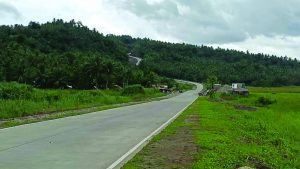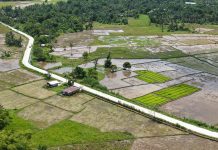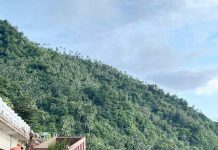Samar Pacific Coastal Road Project

(ROEL T. AMAZONA)
PALAPAG, Northern Samar – This remote town will finally be connected to the rest of the province with the opening of a road and bridge on July 14.
Palapag has been existing for 437 years but remains to be isolated from the rest of the province until the opening on July 14 of the 11.6 kms Samar Pacific Coastal Road Project (SPCRP).
The road and bridge project, funded by the South Korean government through its Export-Import Bank, also connects the towns of Laoang and Catubig to the rest of the province.
Prior to the construction of the said SPCRP, also known as Simora-Palapag road project, residents of the town have to travel via sea transport if they are to go to the nearby towns or to the provincial capital of Catarman.
Elena Aoyang, who owns a general merchandise business, said that the road finally solve their travel woes.
“The impact of this project to us Palapag residents is immense, especially for traders and businessmen who need to cross a body of water when buying and bringing goods to our town,” she said.
The cost of fare for every passenger of a sampan, as the passenger motorboat is known by the locals, is P10 per person. If they have a motorcycle they need to pay P70. For those with goods, the cost would reach P500, and P1,200 if they will bring with them a vehicle.
The completion of the project will not only benefit the traders and businessmen but also the local tourism industry of the municipality and its neighboring towns.
Palapag, a historical town, has great potential to attract local, domestic, and even international tourists.
The road will ‘awaken’ the tourism potential of their town, Paul Go, who is the local civil registrar chief and tourism-designate officer.
“This will have a great contribution to our local economy and to the business sector particularly those in the accommodation and restaurant businesses”, he added.
Palapag is the birthplace of Agustin Sumuroy, the leader of the first Filipino to lead a revolt against Spanish occupation that took place in 1649 to 1650, older than the more popular and longer Dagohoy revolt of Bohol that happened after a century from 1744 to 1829.
The old church of Palapag, a remnant of the Spaniards occupation, can still be seen in the municipality.
Aside from being a historical town, Palapag is also blessed with waterfalls, mountains that are good for trekking and climbing, beaches, rock formations, and an islet that is popular among locals for camping.
What the municipality is doing now is developing these tourism sites, organizing people’s organizations, and encouraging tourism-related businesses to accredit with the Department of Tourism, Go added.
But while the majority of residents are thankful that finally their town is connected to the main provincial road, there are members of sectors, particularly in the transportation industry, who fear that soon they no longer have the income to sustain the needs of their family.
Sirenaldo Sua, 73, a sampan operator, said that since the road was open for vehicles to use, travelers crossing the old route massively declined. From the almost P4,000 a day income that he earned before the road was constructed, it dived to P1,000 a day.
Habal-habal driver Jomar Oladive, 32, also shares the same sentiment with Sua adding that aside from most travelers prefer the new road, most residents in the Pacific Coastal towns particularly students now owned motorcycles for their service.
From more than P1, 000 income a day as habal-habal driver, he now only earns more than P500.
The two said that they acknowledge the importance of their town to be connected to the national highway even if it affects their source of livelihood.
“We can’t do anything about it, and we need that road. But we also need help, the drivers and operators for us to earn to support our family”, Oladive said.
During the inauguration of the Simora-Palapag road led by President Ferdinand ‘Bongbong’ Marcos Jr., it was announced by Department of Public Works and Highways Secretary Manuel Bonoan that there is a second phase of the coastal road project.
This project includes the construction of a bridge from Rawis to the island of Laoang, and another bridge from Laoang that will connect to Palapag.
Once this road is materialized, Palapag Mayor Florence Batula said that this will heavily affect sampan operators and will displace them economically.
But the local government has already prepared plans to support them and prepare the sector by coordinating with government agencies who can help them in providing alternative livelihood.
A feasibility study is now ongoing and included in it are interventions needed for the families that will be displaced and sampan operators whose income will be affected by the project. (ROEL T. AMAZONA)



